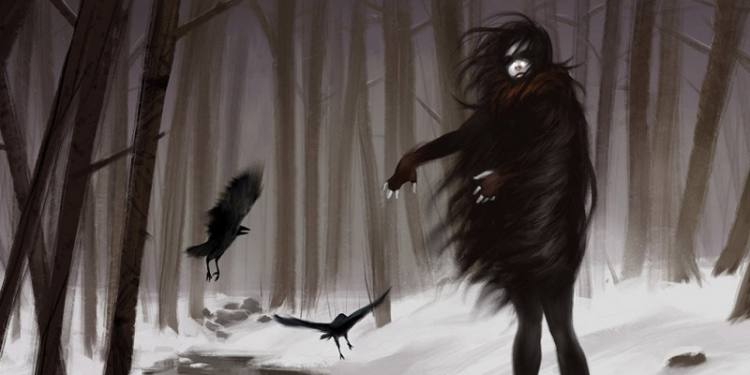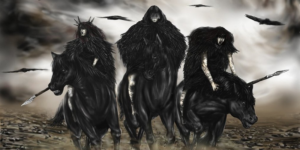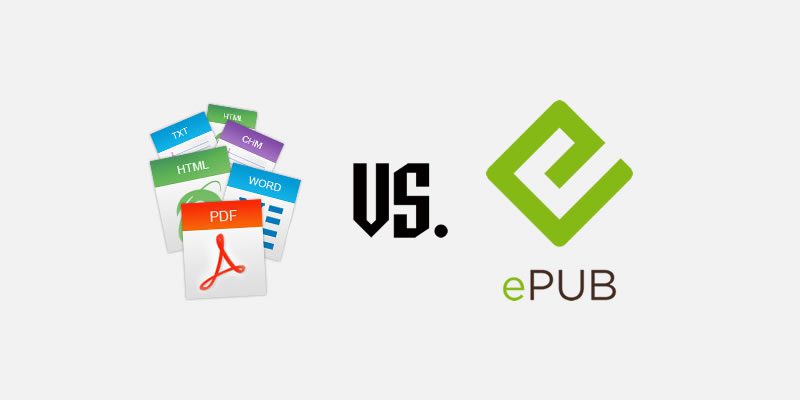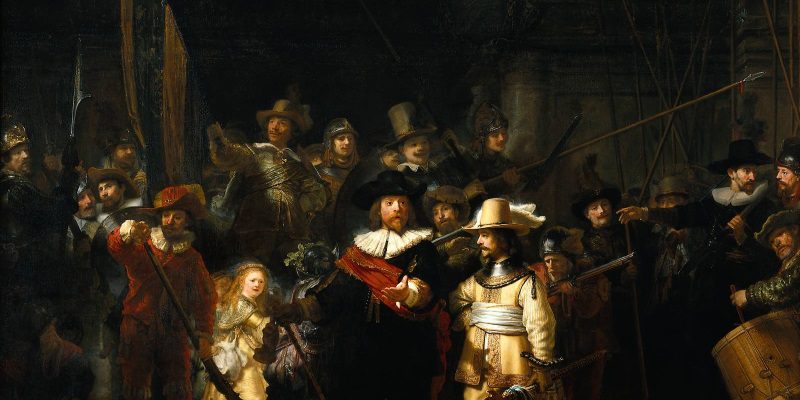Get to Know the Morrígan

Celebrate and rejoice. Tribality is now a threenager. It’s that time where we test boundaries, drive our parents crazy, and throw the concept of naps to the floor while kicking and screaming. Okay – maybe that isn’t true for the rest of the Tribality staff, and I am just projecting. Regardless, this month we honor Tribality’s third anniversary by focusing on the threes. First on the Performance Check docket is a return to the “Get to Know” series to discuss the Irish goddess the Morrígan. Or is it the Mórrígan? Maybe it’s the Morrígu? Nah, it’s probably Morríghan or Mór-Ríoghain. Let’s get to know the Morrígan.
The Get to Know Family: Azer | Kenku | Giants | Scarecrow | Erinyes | Crossroads | Death Knight | Merfolk | Celestials | the Morrígan
As with all of these articles, this needs a disclaimer. I am not a religious or historical researcher. If you have deep-dive information that contradicts this then awesome. I look forward to reading it in the comments. Let’s just not be donkuses about it.
A Bit of History
If it wasn’t obvious from my name, let’s just say my family has more than a skosh of Irish heritage. Despite that, it wasn’t until I was in my teens that I even figured out there was such a thing as Irish mythology. Unlike Greek, Roman, Norse, and Egyptian mythology, we didn’t cover Irish or Celtic mythology – that I recall – in any class I took. This has a lot to do with the religious syncretism occurring with the spread of Christianity, and the religious conversion of many of the inhabitants. Even during Rome’s heyday, the combining of Celtic and Roman gods happened frequently. For example, Cernunnos and Dis Pater spring to mind – even if Pluto later became an amalgamation of both.
At any rate, it wasn’t until the release of Dark Age of Camelot in 2001 the realization there was a Celtic mythology struck me. American Gods hammered home the realization the same year. It was in this novel that several Celtic gods and goddesses made an appearance, one of which was the Morrígan.

Inherent Radness
From the top to the bottom, there is no escaping the fact the Morrígan is ultra-cool. There aren’t a lot of things I would describe as ultra-cool, but the Morrígan is one of them. I am now uncertain what else I would describe as ultra-cool – Bill Murray and red pandas, maybe. Anyway, take that list and add the Morrígan to it. Take her name, for instance. The Morrígan probably stems from the Indo-European root ‘mor’ – meaning terror or monstrous – and ‘rígan’ – meaning queen. You might recognize ‘mor’ as similar to ‘maere’, ‘mara’, or ‘mare’ – and for good reason. They are cognates of each other. The stuff of nightmares, you might say.
Of course, the reason the word ‘probably’ appears above is because there is a small dispute of the root. Some scholars say instead of the root being ‘mor’ it is actually ‘mór’ – meaning great. This changes the meaning of the name significantly – “great queen” is substantially different than “terror queen”. However, the second meaning is less likely, and is rooted in a desire to link the Morrígan to Morgan le Fay. Most scholars agree this is not the case, nor are they the same figure – different cultures and linguistic branching bear this out. Further, the most popular interpretation of the name isn’t “terror queen” or “monstrous queen”, but rather “phantom queen”. How rad is that?
Historical History of Histories
In a factoid that might interest only me, one of the first appearances is in a 9th century translation of the Book of Isaiah.In one passage it mentions the Hebrew Lilith as a Lamia, and goes on to describe it as “a monster in female form, a morrígan”. Prior to this, some 8th century glossaries mention the morrígna – the plural of Morrígan. It’s in these same texts that name Macha as one of the three morrígna. As mentioned above, the Morrígan is three sisters – usually Badb, Macha, and Nemain, but sometimes Anand, Ériu, Banba and Fódla appear as members instead of the others. Anand is probably just another name for the Morrígan – even though this is an Irish name and goddess, the British call her by the terrifying name Gentle Annie. The other three are daughters of Emmas – a goddess – of the Tuatha Dé Danann.
Fey and What Not
The Tuatha Dé Danann are a supernatural race that once ruled Ireland. This roughly translates as “people of the goddess Danu” – Danu is another name for Anand (probably) – though if you leave it as Tuath Dé the name instead means “tribe of gods”. The Tuath Dé live primarily in the Otherworld. The Celtic Otherworld is a place of everlasting beauty, youth, health, and joy, while also being the home of the gods and the dead. Heroes sometimes entered the Otherworld through invitation or stumbling upon it in caves, underwater, at burial mounds, or “going across the western seas”. The Otherworld overlaps the physical world, with things like magical mist, weird-ass animals, places of supreme beauty, and the gods showing up being indications of Otherworld intrusion.
The Tuatha Dé Danann were frequently viewed as the benevolent side of nature – though not exclusively so – with their rivals – the Fomorians – being viewed as the destructive side of nature. This probably all sounds so very familiar to the fey-versed out there.
Anyway, back to the Morrígan.

Cycles Upon Cycles
As far as Irish mythology goes, the Morrígan starts to gain important with the Ulster Cycle. The Ulster Cycle is one of the four great cycles – think sagas if you are familiar with Norse lore – of Irish mythology. It follows the heroes of the Ulaid, focusing heavily on Sexy Irish Hulk and Sexy Captain Ireland (Conall Cernach – mah boy!). It’s here the Morrígan makes an appearance. I will do my best to sum this up.
A History Quicky, by Colin
Sexy Irish Hulk: “Don’t scare my cows!”
The Morrígan: *turns into a crow* “Caw!”
Sexy Irish Hulk: “My bad. I take it back. Let’s be friends.”
The Morrígan: “Nah, I’m only friends with people that are going to live. LOL.”
Back To Your Regularly Scheduled Getting to Know
Thus we see the core tenants of the Morrígan on display. She turns into a crow, and she foretells his death in battle. The aspect of sovereignty crops up later in the saga when the Morrígan turns into a crow to tell a cow he should run away to be free, and in the second set of interactions with Sexy Irish Hulk – which revolve around how the Morrígan wants to bone him, but he is still mad about the first encounter so he passes. Jokes on him, he still dies.
The Other Side of the Coin
This is significant when taken with the events of the Mythological Cycle. Here we see her listed among the Tuatha Dé Danann as a daughter of Emmas. The morrígna appear as additional daughters, alongside Ériu, Banba and Fódla. This isn’t a surprise, as the cycle focuses on the gods instead of mortal – or near mortal – heroes. It was also part of an attempt to codify and solidify the disparate Irish, Celtic, and Gallic traditions. On Samhain – you know, around October 31 and what not – the Morrígan keeps a sexual liaison with the Dagda. The Dagda is….I don’t know, Sexy Irish Odin? Well, he has a murder staff instead of a murder spear, has both eyes, and is sans stabbings. He controls time, the weather, and is the personification of manliness, wisdom, and magic. Also nature. His name loosely translates as the “all-father” or “great father”, so close enough. Sexy Irish Odin. Anyway, unlike Sexy Irish Hulk, Sexy Irish Odin has a tryst with the Morrígan.
After they have Otherworldly Hanky Panky, the Morrígan summons all the wizards of Ireland to drain all of the blood from the invading Fomorian king. When the rest of the forces attack, the Morrígan reads a poem that causes all of the Fomorians to just go drown in the sea, instead. In short, a covenant with the land reaps rewards.
Get to Know the Morrígan
The Morrígan mentioned in the Ulster Cycle is primarily Badb, with a touch of Macha. Badb means “crow” and is a war goddess who transforms into a crow. She sows chaos in battle to manipulate the outcome, and she predicts battles and the deaths of notable people before they occur. Interestingly, her “wailing cry” was sometimes used as the method of prediction, much like the bean sidhe. However, her two sister also play a crucial role in the mythology of the Morrígan. Nemain – “the Great Taker” – is a goddess of battle frenzy. Her piercing cry causes mass confusion, including combatants attacking their allies. Oh, and her presence was so terrifying as to cause mere mortal to die of fright. Last but not least, we have Macha.
Macha is the most frequently named of the morrígna. Before we continue, let’s acknowledge the existence of the phrase “Mesrad Machae” – the Mast of Macha. This refers to “the heads of men who have been slaughtered”. Of the three, she is the one who identifies as the goddess of sovereignty and kingship (also horses, I guess). In Irish folklore, to be a goddess of sovereignty is to also be a goddess of the land. You probably recall the earlier mention of the goddess Ériu. Ériu and her sisters asked that the land to retain their names forever more. Well, one out of three ain’t bad. Ériu land. Ireland. Ériu was also a goddess of sovereignty and kingship, and it is easy to see in this example how she becomes a goddess of the land. It makes sense that goddesses that follow in her tradition share the same mantles.

Lasting Impact
Of all the Celtic mythological figures, the Morrígan might be the most popular and mainstream. I mean, I’m all in for Fionn mac Cumhaill, Lugh, and Conall Cernach, but they don’t have nearly the presence in other mediums like the Morrígan. Cú Chulainn is pretty close to the Morrígan’s pop culture footprint, and might possibly surpass her. However, I’d be willing to wager a few dollars that more people are familiar with the Morrígan than ol’ Sexy Irish Hulk. Part of this is due to the depiction of the goddess. A fortune-telling shapeshifter that governs fate, battle, and sovereignty that is actually not one goddess but three – called the three Morrígna – is fairly memorable stuff.
The Morrígan is one of the most popular Irish mythological figures. She is a popular figure in the ever-expanding graphic novel world – The Wicked + The Divine and A Dirty Job, for example. Heavy metal bands love her – including Glenn Danzig and Primordial. She’s a succubus in Darkstalkers, for some reason – opening up all sorts of anime love – Sexy Irish Hulk gets the same treatment. Stargate SG-1 touched on her, of course. She plays a big role in Lost Girl, the fey-centric urban fantasy show. George R.R. Martin even gets in on the action – House Morrigen of Crow’s Nest. This is to say nothing of the huge role a character named Morrígan receives in Dragon Age: Origins. The story of Flemeth and Morrígan cleave very close to the source material when you take them together – and you should. The Morrígan can transform into an old hag, after all.
Knowing is Half the Battle
The mantle and popularity of the morrígna lies in their sisterhood. While each of them is powerful, the fact that all three comprise the goddess give her additional strength.Individually, they are fearsome divine figures. When they combine to leave others guessing who they are encountering, it’s even more terrifying. This, above all of the other rad things, is why I like the Morrígan so much. The morrígna are enigmatic figures going out and being badass. Working together to be the baddest they can possibly be just solidifies it. It also makes the Morrígan a great choice to cover for Tribality’s third birthday.
We might all be badasses, but not as badass as we are together. Here’s to another year.



